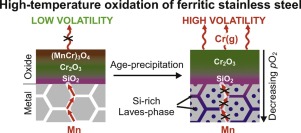当前位置:
X-MOL 学术
›
Corros. Sci.
›
论文详情
Our official English website, www.x-mol.net, welcomes your
feedback! (Note: you will need to create a separate account there.)
The role of (FeCrSi) 2 (MoNb)-type Laves phase on the formation of Mn-rich protective oxide scale on ferritic stainless steel
Corrosion Science ( IF 7.4 ) Pub Date : 2018-03-01 , DOI: 10.1016/j.corsci.2017.12.026 Harri Ali-Löytty , Markku Hannula , Timo Juuti , Yuran Niu , Alexei A. Zakharov , Mika Valden
Corrosion Science ( IF 7.4 ) Pub Date : 2018-03-01 , DOI: 10.1016/j.corsci.2017.12.026 Harri Ali-Löytty , Markku Hannula , Timo Juuti , Yuran Niu , Alexei A. Zakharov , Mika Valden

|
Abstract Microalloying of stainless steel with reactive elements increases oxidation resistance but makes the alloy prone to microstructural changes. XPS results reveal changes in the initial oxidation mechanism on Ti–Nb stabilized ferritic stainless steel (EN 1.4521) after 120 h heat treatment at 650 °C. Age-precipitation of (FeCrSi)2(MoNb)-type Laves phase resulted in less pronounced surface segregation and oxidation of microalloying elements. Si oxidizes preferentially at the Laves precipitate locations via outward diffusion forming diffusion barrier for the other scale forming elements. Most significantly the diffusion of Mn and the formation of low volatile (Mn,Cr)3O4 spinel oxide at the surface was strongly suppressed.
中文翻译:

(FeCrSi) 2 (MoNb)型Laves相对铁素体不锈钢富Mn保护性氧化皮形成的作用
摘要 含有活性元素的不锈钢微合金化提高了抗氧化性,但使合金容易发生显微组织变化。XPS 结果揭示了 Ti-Nb 稳定铁素体不锈钢 (EN 1.4521) 在 650 °C 下热处理 120 小时后初始氧化机制的变化。(FeCrSi)2(MoNb) 型 Laves 相的时效沉淀导致微合金元素不太明显的表面偏析和氧化。Si通过向外扩散在Laves沉淀位置优先氧化,形成其他结垢元素的扩散屏障。最显着的是,Mn 的扩散和表面低挥发性 (Mn,Cr)3O4 尖晶石氧化物的形成受到强烈抑制。
更新日期:2018-03-01
中文翻译:

(FeCrSi) 2 (MoNb)型Laves相对铁素体不锈钢富Mn保护性氧化皮形成的作用
摘要 含有活性元素的不锈钢微合金化提高了抗氧化性,但使合金容易发生显微组织变化。XPS 结果揭示了 Ti-Nb 稳定铁素体不锈钢 (EN 1.4521) 在 650 °C 下热处理 120 小时后初始氧化机制的变化。(FeCrSi)2(MoNb) 型 Laves 相的时效沉淀导致微合金元素不太明显的表面偏析和氧化。Si通过向外扩散在Laves沉淀位置优先氧化,形成其他结垢元素的扩散屏障。最显着的是,Mn 的扩散和表面低挥发性 (Mn,Cr)3O4 尖晶石氧化物的形成受到强烈抑制。











































 京公网安备 11010802027423号
京公网安备 11010802027423号